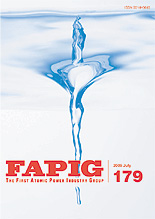![]()
FAPIG
THE FlRST ATOMlC POWER INDUSTRY GROUP
FAPIG誌 最新号目次
2009−7/平成21年度 第1号(No.179)

|
目 次 ■ 紹 介 ■ 論 文 ■ グループ情報 表紙デザイン:永瀬恭一
CONTENTS ■ Introduction ■ Paper Cover Design:Kyouichi Nagase
SYNOPSES Takakazu Saito, Kazuyuki Imaizumi, Kiyoshi Oka, Hideyuki Aizawa, Gen-ichi
Katagiri O-arai Research and Development Center, Japan Atomic Energy Agency
has developed a reactor internal inspection device using a fiberscope
and a camera as part of the development of reactor internal inspection
and repair techniques for sodium-cooled fast reactor, and obtained findings
about applicability of the device and inspection techniques through
reactor internal inspection of “Joyo” KEYWORDS:“Joyo”, sodium cooled fast reactor, inspection techniques, repair techniques, visual inspection Mitsuhiro Imai Fuji Electric Systems Co., Ltd supplies a lot of monitoring systems
for continuous measurement and monitoring of environmental radiation
around Nuclear power plants and facilities associated with them. KEYWORDS:environmental radiation monitoring system, backup power supply, satellite communication channel, earthquake Toshiyuki Okubo, Mamoru Harada, Yasushi Donomae, Kouji Satou, Toshiya
Kakuta, Takeshi Matsumoto Oarai Waste reduction Treatment Facility (OWTF) will be constructed
in Oarai Research and Development Center of JAEA. OWTF is the facility
for carrying out the volume reduction processing of high dose α radioactive
solid waste. KEYWORDS:OWTF, radioactive solid waste, volume reduction, incinerating and melting treatment, high-frequency induction furnace Tatsuya Ozawa, Satsuki Takenaka, Keisuke Buma, Koji Sato In the radioactive material handling plants like a nuclear power station,
various works are performed in the cell for preventing contamination
spread. For example, some remote controlled equipments would be used
for removal and maintenance of a machine installed in the cell. KEYWORDS:cell, remote controlled equipment, approaching operation, approach directing facility Misawa Makoto, Nagamori Fumio The System for Prediction of Environmenta1 Emergency Dose lnformation
(SPEEDI) Network System is a computer system capable of rapidly predicting
the effect that radioactive materials will have on the surrounding environment
if there is a massive release of radioactive materials from a nuclear
facility. The Ministry of Education, Culture, Sports, Science and Technology
consigns the operation of the SPEEDI Network System to the Nuclear Safety
Technology Center (NUSTEC). NUSTEC has developed the main functions
of the SPEEDI Network System and Fujitsu provided continuous support
with regards to the system construction, operation and maintenance,
such as the introduction of servers and improvement of networks. KEYWORDS:SPEEDI network system, radioactive materials, nuclear facility, nuclear safety technology center Shin'ya Nishio, Hirokazu Sugiyama, Tohru Abe, Eiji Ogisako, Takuro
Odahara, Akihiro Hachikubo, Satoshi Yamashita, In August 2008, we successfully demonstrated the recovery of methane gas from the bottom of Lake Baikal where the water depth was about 400m. A steel chamber with a diameter of 1.2m and equipped with 32 water jet nozzles was used for gas recovery. We attempted to recover methane hydrate by dissolving it in water and pumping it up. The water jets were installed to excavate the sediments and dissolve methane hydrate in water. According to the measurements of the volume composition and the isotopic composition of recovery gas, the recovered hydrocarbon gas originates from the methane hydrate layer. This system can be effectively used for gas recovery from near-surface methane hydrate. KEYWORDS:methane gas recovery test, near-surface methane hydrate, Lake Baikal, chamber, water jet Takeshi Izumi, Masahiro Hagiwara, Takao Ino, Makoto Komatsu, Hideo
Kawazu, Kunio Fujiwara Mixed bed of ion exchange resins are installed at the primary loop in steam power plants and at the use points in semiconductor plants in order to remove ion impurities and make the ultrapure water. Recently, required water quality becomes higher and higher and so, the leachables from the cation exchange resins are identified as a main source of impurities. We have been developing the anion exchange fiber filers (AEF) that were synthesized from polyethylene (PE) non-woven fabric by using radiation-induced graft polymerization (RIGP). The removal characteristics of these filters for leachables from cation exchange resins (HCR-W2, ETR-C3) was investigated. Some fiber filters remove leachables more efficiently than anion exchange resin (550A). In particular, AEF that has finest fiber diameter shows 74% of removal efficiency for the leachables from HCR-W2. It suggests that larger surface area of the filter contributes to the adsorption rate for leachables. KEYWORDS:anion exchange fiber filers, radiation-induced graft polymerization, leachables, cation exchange resins |
バックナンバー目次
|
号数 |
発行年月 |
| 178 | 2009/ 2 |
| 177 | 2008/ 7 |
| 176 | 2008/ 2 |
| 175 | 2007/ 7 |
| 174 | 2007/ 2 |
| 173 | 2006/ 7 |
| 172 | 2006/ 3 |
| 171 | 2005/11 |
| 170 | 2005/ 7 |
| 169 | 2005/ 3 |